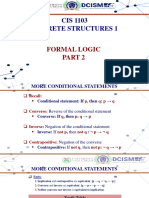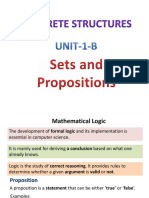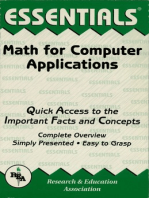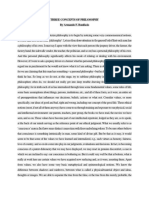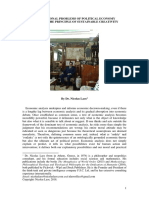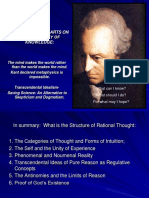Discrete 1
Uploaded by
sudhirikkeDiscrete 1
Uploaded by
sudhirikkeAkAsHViShAl
III Year V Semester CSE
MA2265 Discrete Mathematics
Om Sakthi
ADHIPARASAKTHI COLLEGE OF ENGINEERING
G.B. NAGAR, KALAVAI 632 506.
DEPARTMENT OF COMPUTER SCIENCE & ENGINEERING
Year / Sem
: III / V
Sub. Code & Subject
MA2265-
Discrete Mathematics (DM)
TWO MARK QUESTION & ANSWERS
Unit-I&II
1.Define negation?
If p is a statement, then negation of p written as ~p (or ~p } or 7p and read as not p. the truth
table is as follows
p
~p
T
F
F
T
Example: P: madras is a city
~p:madras is not a city or it is not the case that madras is a city.
2.define conjunction?
The conjunction if 2 statements P and Q is the statement P^Q which is read as P and Q. the
statement P^Q has a truth value T whenever both P and Q have the truth table T; otherwise it
has truth value F. the conjunction is defined by the truth table as follows.
P
Q
P^Q
T
T
T
T
F
F
F
T
F
F
F
F
Example : P : jack went up the hill
Q: jill went up the hill
P^Q: jack and jill went up the hill
3.define disjunction?
The disjunction of 2 statements P and Q is the statement P v Q which is read as P or Q. the
statement P v Q has a truth value F only when both P and Q have truth value F otherwise it is
true. The disjunction is defined by following table.
P
Q
PvQ
Adhiparasakthi College of Engg., G.B. Nagar, Kalavai
CD / Page 1 of 10
AkAsHViShAl
III Year V Semester CSE
MA2265 Discrete Mathematics
T
T
F
F
T
F
T
F
T
T
T
F
Example :
1.I shall go to market or a cinema.
2. there is something wrong with the bulb or wiring.
4.state molecular statements?
Those statements which contain one or more atomic statements and some connectives are
called molecular statements.
Examples;
~P,P^~Q,P v Q.
5. Define conditional and biconditional?
If P and Q are any two statements then the statement P-> Q which is read as if P then Q is
called a conditional statement. Here P is called antecedent and Q is called consequent.
Truth table:
P
T
T
F
F
Q
T
F
T
F
P-.>
T
F
T
T
Example:
P: it is hot.
Q: 5+3=8.
p-> is false only when P is true and Q is false. Otherwise p->Q is true.
Biconditional
If P and Q are any two statements , then the statement P<-> which is read as P if only if Q is
called Biconditional statement , the statement p<->Q has the truth value T whenever both P
and Q have identical truth values . the truth table for biconditional is as follows;
Q
P
P
T
T
F
f
T
F
T
F
T
F
F
T
6.define Tautology and Contradiction?
A statement formula which is true regardless of the truth values of the statements which
replace the variables in it is called a universally valid formula or a tautology or a logical truth.
Adhiparasakthi College of Engg., G.B. Nagar, Kalavai
AkAsHViShAl
CD / Page 2 of 10
III Year V Semester CSE
MA2265 Discrete Mathematics
Example:
P v~P
P
T
F
~P
PV~P
F
T
T
T
Contradiction:
A statement formula which is false regardless of the truth table values of the statements which
replace variables in it is called a contradiction.
Example:
P^~P
Truth table for PV~P
P
~P
P^~P
T
F
F
T
F
F
7.define Duality law?
Two formula A and A* are duals of each other if other if either one can be obtained from the
other by replacing^ and v are also called duals of each other.
8.prove the following implications :
(i) (P^Q)=>(P->Q); (ii)P=>(Q->p)
Assume the consequent to be false (i.e)P->Q is false . by definition of conditional P is True and
Q is false
(ii) Assume Q->P is false Q is True but P is false. Therefore P is false.
9.define DNF and CNF
DNF:
A formula which is equivalent to a given formula and which consists of sum of elementary
products is called a disjunctive normal form of the given formula.
CNF:
A formula which is equivalent to a given formula and which consists of product of elementary
sums is called conjuctive normal form of the given formula.
10.state inference theory?
Rule P: a given premises may be introduced at any stage in the derivative.
Rule T: a formula S may be introduced in a derivation if S is tautologically implied by one or
more of the preceding formula in to derivation.
Rule CP: if the conclusion is the form R->S then we include R is an additional premises and
derive S from the given act of premises and R.this rule is called rule CP.
11.define PDNF and PCNF
PDNF: a formula which is equivalent to a given formula which is consists of sum its minterms is
called PDNF.
Adhiparasakthi College of Engg., G.B. Nagar, Kalavai
CD / Page 3 of 10
AkAsHViShAl
III Year V Semester CSE
MA2265 Discrete Mathematics
PCNF: a formula which is equivalent to a given formula which consists of product of maxterms
is called PCNF.
12.construct the truth table for (q ^ (P->Q))->P)
Solution;
P Q P->Q Q^(P->Q) (Q^(P->Q))->P
T T T
T
T
T F F
F
T
F T T
T
F
F F T
F
T
13 .construct the truth table for (P^Q)v()7p^Qv(P^7Q)v(7p^7Q)
Solution;
p
Q
7P
7Q
P^Q
7P^Q
p^7Q
7P^7Q T
R
S
T
T
F
T
T
F
T
F
F
F
T
T
F
T
F
T
T
F
F
F
F
F
T
F
F
T
F
F
F
F
F
T
T
F
T
F
F
T
F
T
T
T
T
T
14.construct the truth table for (PvQ)v7P
Solution:
P Q PVQ 7P (PVQ)V7P
T T T
F T
T F T
F T
F T T
T T
F F F
T T
15.construct the truth table for (P->Q)^(q->P)
Solution:
P Q P->Q Q->P (P->Q)^(Q->P)
T T T
T
T
T F F
T
F
F T T
F
F
F F T
F
T
16.construct the truth table for(P->Q)<->(7PVQ)
Solution:
P Q 7P P->Q 7PVQ (P->Q)<->(7PVQ)
T T F T
T
T
T F F F
F
T
F T T T
T
T
F F T T
T
T
17.find the PDNF for 7PvQ
Adhiparasakthi College of Engg., G.B. Nagar, Kalavai
CD / Page 4 of 10
AkAsHViShAl
III Year V Semester CSE
MA2265 Discrete Mathematics
Sol:
7pvQ(7P^T)v(T^Q)
(7P^(Qv7Q))v((Pv7P)^Q)
(7P^Q)v(7P^7Q)v(P^Q)v(7P^Q)
(P^Q)v(7P^Q)v(7p^7Q)
18.obtain the PDNF for P->((P->Q)^7(7Qv7P))
Solution;
P->((P->Q^7(QV7P))
P->((7PVQ)^(Q^P))
7PV(7PVQ)^(Q^P))
7P^(QV7Q)V(F^Q)V(P^Q)
(7P^Q)V(7P^7Q)V(P^Q)
UNIT-III&IV
1.Define a simple statement function.
A simple statement function of one variable is defined to be anexpression consisting of a
predicate symbol and an individual variable. Such a statement function becomes a statement
when the variable is replased by the name of any object.
Ex:
If X is a teacher is denoted by T(x),it is a statement function.if X is replased by John,then
Johan is a teacher is statement .
2.Define a compound statement function.
A compound stament function is obtained by combining one or more simple statement
functions by logical connectives.
Ex:
M(x)^H(x)
M(x)->H(x)
M(x) 7H(x)
An extension of this idea to the statement functions of two or more variables is straight
forward.
3.Define universal Quantifiers and existential Quantifiers.
Universal Quantifiers:
The universal Quantification of P(x) is the proposition.P(x) is true for all values of x in the
universe of discourse.
The notation x P(x) denotes the universal quantification of P(x).here is called the
universal quantifier.
Existential Quantifier:
The existential Quantification of P(x) is the proposition. There exists an element x in the
universe of discourse such that P(x) is true.
We use the notation x P(x) for the existential quantification of p(x).here is called the
existential quantifier.
4. what are the rules of Quantifier?
Adhiparasakthi College of Engg., G.B. Nagar, Kalavai
CD / Page 5 of 10
AkAsHViShAl
III Year V Semester CSE
MA2265 Discrete Mathematics
1.Rule US (Universal specification)
2.Rule UG (Universal generalization)
3.Rule ES (Existential Specification)
4.Rule EG (Existential Specification)
5.what are the rules of inference?
1. Rule P
A given premises may be introduced at any stage in the derivation.
2. Rule T
A formula S may be introduced in a derivation if S is tautologically implied by one or more of
the proceeding formulae in the derivation .
3. Rule CP
If we can derive S from R and a set of given premises,then we can derive R->S from the set of
premises alone.
6. symbolize the expression x is the father of the mother of y
P(x) :
x is a person
F(x,y) :
x is a father of y
M(x,y) :
x is a mother of y
We symbolize this as(z)(p(z)F(x,z)M(z,y))
7. Express the statement, Some people who trust others are rewarded in symbolic form.
(x)[P(x)T(x)R(x)]
P(x) : x is aperson
T(x) : x trusts others
R(x) : x is rewarded
8. Give an example of free and bound variable in predicate logic.
(x) P(x,y) : x is a bound variable
Y is a free variable
9. Define statement function of one variable. When it will become a statement?
Statement function of one variable is defined to be an expression consisting of a
predicate symbol and an individual variable. The statement function becomes a statement,
when the variable is replaced by the name of an object.
10. Use quantifiers to express the associate law for multiplication of real numbers.
Universe of discourse: Set of real numbers.
P(x,y,z): (x*y)*z
Q(x,y,z): x*(y*z)
(x)(y)(z)(P(x,y,z) Q(x,y,z))
11. Define simple statement function.
A simple statement function contains a predicate symbol followed by one (or) more
variables. It gives the statement when the variables are replaced by objects from a designated
set.
EX:
R(x) : x is Red
Q(x,y) : x+y=10
Adhiparasakthi College of Engg., G.B. Nagar, Kalavai
CD / Page 6 of 10
AkAsHViShAl
III Year V Semester CSE
MA2265 Discrete Mathematics
12. Express the statement For every x there exist a y such that
symbolic form.
Universe of discourse = Set of all integers.
in
(x)(y)(
13.Give an example to show that (x) (A(x) B(x)) need not be a conclusion from(x) a(x) B(x).
Let the universe of discourse be the set of all integers.
Let A(x) : 2x + 1 = 5 and B(x) :
The statements (x) A(x) and(x)B(x) are true. The statement (x)(A(x)B(x)) is false,
because there is no integer a such that 2a+1=5and
14.show that ~P(a,b)follows logically from (x),(y)(P(x.y)->W(x,y)and ~W(a,b)
(i) (x)(y)(P(x,y)->W(x,y)
rule P
(ii) (y)(P(a,y)->W(a,y))
US,(i)
(iii) P(a,b)->W(a,b)
US ,(ii)
(iv) ~W(a,b)
rule P(v) ~P(a,b)
rule T(iii,iv)
15. show that (x) (p(x))->Q(x))^(x)(Q(x))->R(x))=>(x)(p(x))->R(x))
Solution;
Sno
Premises
Rule
reason
1
(x)(p(x))->Q(x))
P
Given premises
2
P(a)->Q(a)
T
From(1),US rule
3
(x)(Q(x)->R(x))
P
GP
4
Q(a)->R(a)
T
From(3),US rule
5
P(a)->R(a)
T
From(2),(4)(p->Q),(Q->R)=>P->R
6
(x)(p(x)->R(x))
T
From(5),UG rule
16.using CP or otherwise obtain the following implication
(x)(P(x))->Q(x)),(x)(R(x)-> ~Q(x))=>(x) r(x)->~P(x)
Solution:
Sno Premises
rules Reason
1
(x)(p(x)->Q(x) P
Given premises
2
P(a)->Q(a)
T
US rule
3
R(x)
P
Additional premises
4
(x)(R(x)P
GP
>~Q(x))
5
R(a)->~Q(a)
T
US rule
6
~(~Q(a)->~R(a) P
From (5)
P->Q~Q->~P
7
Q(a)->~R(a)
T
From(6)
8
P(a)->~R(a)
~(~R(a))->~P(a) T
From(8)
10
11
R(a)->~P(a)
(x)(R(x)>~P(x)
From(9)
UG rule
T
T
From(2)&(7)P->Q
Adhiparasakthi College of Engg., G.B. Nagar, Kalavai
CD / Page 7 of 10
AkAsHViShAl
III Year V Semester CSE
MA2265 Discrete Mathematics
17.which of the following are statements?
i.(x)(P(x)vQ(x))^R.
ii.(x)(P(x)^Q(x))^S(x)
solution:
i.is not a statement
ii.is a statement
18.using CP ot otherwise obtain the following implication:
(x)(P(x)->Q(x)),
(x)(R(x)->7Q(x))=>(x)(R(x)->7P(x))
Sol:
(x)(P(x)->Q(x)) rule P
2.(x) R(x)->7Q(x) rule T
3.Q(x)->7R(x) rule T,,2,3
4.R(x)->7P(x) rule T,4
Unit-V
1.define function.
Let X and Y be any two sets A relation f from X to Y is called a function if for every x X there is
a unique y Y such that (x, y)f.
2. define graph of a function.
With each function we can associate a graph ,which is a diagrammatic representation of a
function.if the domain x and codomain Y of a function f are finite,we can represent such a
function as follows
We draw a circle for each element x of X and each element y of Y and join x with y by a
directed line, directed from x to y ,if (x ,y)f
.
3. define identity map
A mapping Ix:X->X is called an identify map if
Ix={(x,x)|{xX}
4. define commutative property
A binary operation f:X x X ->X is said to be commutative if for every x, y X ,f(x, y)=f(y, x).
5 define distributive
A binary operation f: X*X->X denote by * is said to be , distributive over the operation g:X*X>X, denoted by if for every x, y, z X.
X*(yz))=(x*Y)(x*z)
6. define idempotent
Let * be a binary operation on X an element a X is called idempotent with respect to * if
a*a=a.
Adhiparasakthi College of Engg., G.B. Nagar, Kalavai
CD / Page 8 of 10
AkAsHViShAl
III Year V Semester CSE
MA2265 Discrete Mathematics
7. define primitive recursion
A function is called primitive recursive if and if it can be obtained from the initial functions by a
finite number of operations of composition and recursion.
8. define onto (or) surjective (or)surjection
A mapping of f:X->Y is called onto if the range rf =Y; otherwise it is called into.
9.Define injective
A mapping f:X->Y is called one-to -one if it is both one-to-one .such a mapping is also called a
one- to- one correspondence between X and Y.
10. define graph of functions
With each function ,we can associate a graph , which is a diagrammatic representation of a
function if the domain X and codomain Y of a function f are finite , we can represent such a
function as follows.
We draw a circle for each element x of X and for each element of Y and join x with y by a
directed line directed from x to y, if(x, y)f.
11. define identity map
A mapping Ix=X->X is called an identity map if
Ix={(x, x)|{x X}
12. define inverse function
If it is a function from X to Y if f , the converse of f , given by (y, x)f whenever (x, y) f, need
not be a function from Y to X.
13.define binary and n- ary operation
Let X be a set and f be a mapping f:X x X->X then f is called a binary operation on X. in general, a
mapping f: Xn ->Xis called an n-ary operation and n is called the order of the operation . for
n=1,f:X->X is called a unary operation.
14 define primitive recursion
A function is called primitive recursive if and only if it can be obtained from the initial functions
by a finite number of operations of composition and recursion.
15.Define permutation
A bijection from a set A to itself is called permutation of A.
16.define function.
Let x and Y be any two set. A relation F From X to Y is called a function if every X there is a
unique Y such that (X,Y) F.
For a from F : X Y , if (X, Y) F, then Xs c argument and corresponding Y a X . The pair (X, Y)
F, is also written as Y=F ( X ), X is then said to be mapped into XY.
17.define into
Adhiparasakthi College of Engg., G.B. Nagar, Kalavai
CD / Page 9 of 10
AkAsHViShAl
III Year V Semester CSE
MA2265 Discrete Mathematics
Led F: X Y such that there is at least one element b Y which has no pre image under F,
then F is said to be a pinto be a into function from X into Y .
Clear F : X Y is an into function if ( X) = Y.
18.definr one to one
A mapping F : X Y is called one (injection, or 1-1) if distinct element of X are mapped into
element of Y .
In other ,F is one to one if
X1# F( X2) X1 = X2 .
Adhiparasakthi College of Engg., G.B. Nagar, Kalavai
CD / Page 10 of 10
AkAsHViShAl
You might also like
- Chen W (1) .L - Discrete Mathematics Super Cool NotesNo ratings yetChen W (1) .L - Discrete Mathematics Super Cool Notes190 pages
- 094 - MA8351, MA6566 Discrete Mathematics - 2 Marks With AnswersNo ratings yet094 - MA8351, MA6566 Discrete Mathematics - 2 Marks With Answers11 pages
- Discrete Mathematics - Lecture 1 - PropositionsNo ratings yetDiscrete Mathematics - Lecture 1 - Propositions3 pages
- Unit - I Discrete Mathematics: Dr. Krishna Keerthi ChennamNo ratings yetUnit - I Discrete Mathematics: Dr. Krishna Keerthi Chennam105 pages
- Discrete Mathematics: Logic and Proofs Part - ANo ratings yetDiscrete Mathematics: Logic and Proofs Part - A31 pages
- P P Q P PQ P PQ TQ T: MA1453 - Discrete Mathematics Department of CSE, IT and ADS 2023-2024No ratings yetP P Q P PQ P PQ TQ T: MA1453 - Discrete Mathematics Department of CSE, IT and ADS 2023-202463 pages
- Conditional Propositions and Logical Equivalence100% (3)Conditional Propositions and Logical Equivalence30 pages
- Session 4 - Mathematics in The Modern World-Logic-Biconditional StatementNo ratings yetSession 4 - Mathematics in The Modern World-Logic-Biconditional Statement63 pages
- UNIT-I DG & MT (Inference theory and Predicate calculus)No ratings yetUNIT-I DG & MT (Inference theory and Predicate calculus)23 pages
- Rules of Inference For Propositional CalculusNo ratings yetRules of Inference For Propositional Calculus5 pages
- Unit-2 Propositional Logic and Predicate LogicNo ratings yetUnit-2 Propositional Logic and Predicate Logic15 pages
- Systems Construction and Implementation Systems Construction and ImplementationNo ratings yetSystems Construction and Implementation Systems Construction and Implementation20 pages
- Information Systems Development Information Systems DevelopmentNo ratings yetInformation Systems Development Information Systems Development46 pages
- Good Day ! Through This Trick, I Am Going To Control Your Mind Through Your ComputerNo ratings yetGood Day ! Through This Trick, I Am Going To Control Your Mind Through Your Computer4 pages
- Measuring Causes: Invariance, Modularity, and The Causal Markov ConditionNo ratings yetMeasuring Causes: Invariance, Modularity, and The Causal Markov Condition40 pages
- Intelligence by Himanshi (Let's LEARN) PDF100% (1)Intelligence by Himanshi (Let's LEARN) PDF33 pages
- 02 BONIFACIO - Three Concepts of Philosophy100% (1)02 BONIFACIO - Three Concepts of Philosophy3 pages
- The Idea of Language Giorgio Agamben Caner C3a7etiner 12-11-20151No ratings yetThe Idea of Language Giorgio Agamben Caner C3a7etiner 12-11-2015128 pages
- What Is Constructivism? (Attributes) : An Historical PerspectiveNo ratings yetWhat Is Constructivism? (Attributes) : An Historical Perspective6 pages
- Updated Syllabus Introduction To Philosophy100% (1)Updated Syllabus Introduction To Philosophy2 pages
- David Hawkins - The Language of Nature - An Essay in The Philosophy of Science-W. H. Freeman & Company (1964)No ratings yetDavid Hawkins - The Language of Nature - An Essay in The Philosophy of Science-W. H. Freeman & Company (1964)245 pages
- Theoretical Foundations of Artificial General Intelligence100% (5)Theoretical Foundations of Artificial General Intelligence332 pages
- The Nature of Science and The Scientific Method100% (1)The Nature of Science and The Scientific Method11 pages
- Mika Hannula - Juha Suoranta - Tere VadenNo ratings yetMika Hannula - Juha Suoranta - Tere Vaden29 pages
- My Life. My Existence. My Being-In-The-World.: Martin-Heidegger-German-philosopherNo ratings yetMy Life. My Existence. My Being-In-The-World.: Martin-Heidegger-German-philosopher2 pages
- Clatterbaugh Causality in Modern British Philosophy 2002No ratings yetClatterbaugh Causality in Modern British Philosophy 200211 pages
- Annotated Bibliography of Neo-Scholasticism PDFNo ratings yetAnnotated Bibliography of Neo-Scholasticism PDF396 pages
- Chen W (1) .L - Discrete Mathematics Super Cool NotesChen W (1) .L - Discrete Mathematics Super Cool Notes
- 094 - MA8351, MA6566 Discrete Mathematics - 2 Marks With Answers094 - MA8351, MA6566 Discrete Mathematics - 2 Marks With Answers
- Unit - I Discrete Mathematics: Dr. Krishna Keerthi ChennamUnit - I Discrete Mathematics: Dr. Krishna Keerthi Chennam
- P P Q P PQ P PQ TQ T: MA1453 - Discrete Mathematics Department of CSE, IT and ADS 2023-2024P P Q P PQ P PQ TQ T: MA1453 - Discrete Mathematics Department of CSE, IT and ADS 2023-2024
- Session 4 - Mathematics in The Modern World-Logic-Biconditional StatementSession 4 - Mathematics in The Modern World-Logic-Biconditional Statement
- UNIT-I DG & MT (Inference theory and Predicate calculus)UNIT-I DG & MT (Inference theory and Predicate calculus)
- Operational Calculus in Two Variables and Its ApplicationsFrom EverandOperational Calculus in Two Variables and Its Applications
- Systems Construction and Implementation Systems Construction and ImplementationSystems Construction and Implementation Systems Construction and Implementation
- Information Systems Development Information Systems DevelopmentInformation Systems Development Information Systems Development
- Good Day ! Through This Trick, I Am Going To Control Your Mind Through Your ComputerGood Day ! Through This Trick, I Am Going To Control Your Mind Through Your Computer
- Measuring Causes: Invariance, Modularity, and The Causal Markov ConditionMeasuring Causes: Invariance, Modularity, and The Causal Markov Condition
- The Idea of Language Giorgio Agamben Caner C3a7etiner 12-11-20151The Idea of Language Giorgio Agamben Caner C3a7etiner 12-11-20151
- What Is Constructivism? (Attributes) : An Historical PerspectiveWhat Is Constructivism? (Attributes) : An Historical Perspective
- David Hawkins - The Language of Nature - An Essay in The Philosophy of Science-W. H. Freeman & Company (1964)David Hawkins - The Language of Nature - An Essay in The Philosophy of Science-W. H. Freeman & Company (1964)
- Theoretical Foundations of Artificial General IntelligenceTheoretical Foundations of Artificial General Intelligence
- My Life. My Existence. My Being-In-The-World.: Martin-Heidegger-German-philosopherMy Life. My Existence. My Being-In-The-World.: Martin-Heidegger-German-philosopher
- Clatterbaugh Causality in Modern British Philosophy 2002Clatterbaugh Causality in Modern British Philosophy 2002






















